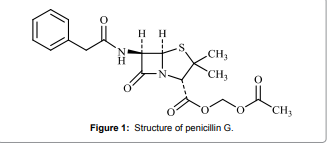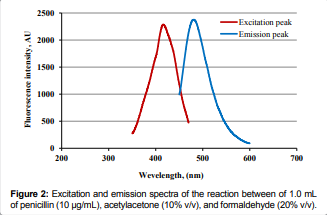Introduction
Penicillin (Figure 1) is considered a broad-spectrum antibiotic. It is referred to as a β-lactam antibiotic,which are among the oldest and the most valuable clinical antimicrobial agents used to treat the bacterial infections of skin, soft tissues, and urinary tract [1]. Due to the presence of penicillin on the Egyptian Market until now, and Egyptian clinicians still use this drug to treat many diseases, we optimized a new method for the easy identification of penicillin. The optimized method was applicable, reliable, and economic. In this study, the advantages of fluorimetric analysis (availability in all quality control laboratories, simplicity, high precision, rapidity, and low reagents and solvents consumption) are combined with the benefits of utilizing the Hantzsch condensation reaction for the spectrofluorimetric determination of penicillin. The chemical reaction variables were studied and the fluorescence variables were optimized on the basis of sensitivity, temperature, and reagent consumption.

Figure 1: Structure of penicillin G.
Experimental
Apparatus
All spectrofluorometric measurements were performed by using a SCINCO spectrafluorimeter (Scinco FS-2, Korea) with a matched 1 cm thick quartz cell. A computer loaded with application software (FluroMaster Plus, version 4.2 Bul, dO3), pH meter (Milwaukee MW101, Atlanta, Georgia, US), andthermostatically controlled water bath (Memmert GmbH, Schwabach, Germany) were used.
Material
All chemicals were of analytical grade and were used without further purification. Bi-distilled water was used throughout. Reference material penicillin was kindly provided by CID-Developing Chemical Industry Co., Egypt. The procedure was applied on vial formulation which was purchased from the local market.
Reagents and Solution
Penicillin solutions: Stock solutions of penicillin (1 mg/mL) were prepared in bi-distilled water and then the working solutions were prepared by further dilution with bi-distilled water to cover their linearity range.
Formaldehyde and acetyl acetone solutions: Formaldehyde, (20% v/v) and acetylacetone (10% v/v) (El-Nasr Chemical Co., Egypt) solutions were freshly prepared by mixing 58.8 and 10.20 mL respectively, to 100 mL bi- distilled water.
Preparation of pharmaceutical dosage form samples: Three vials were weighed and mixed thoroughly, a weighed amount of the powder equivalent to 25 mg of drug was dissolved in 25 mL bidistilled water, mixed well and filtered. Further dilutions with the same solvent were made.
General Recommended Procedure
1.0 mL of sample or standard solution was transferred into a 10-mL calibrated flask. 1.0 mL of acetylacetone and formaldehyde (in the same order) were added, mixed well, and allowed to stand for 50 min in a water bath previously heated to 100OC. After cooling, the solution was completed to the mark with bi-distilled water and measured at the emission wavelength (Em) of 481 nm, after excitation at an excitation wavelength (Ex) of 416 nm.
Results and Discussion
The investigated penicillin drug exhibits very low native fluorescence intensity therefore a derivatization reaction is required to improve its sensitivity and also the selectivity away from the other ingredients associated with its dosage form. The investigated penicillin contains an amine, which is known to react with acetylacetone and formaldehyde through the Hantzsch reaction. Moreover, the reaction product exhibited strong, reproducible fluorescence at an Em of 481 nm. [Figure 2].

The Hantzsch reaction is a known condensation reaction that was reported in the literature as a useful pathway for pyrrole and pyridine synthesis. In the same manner, a combination of acetylacetone and formaldehyde can react with a source of amines forming a faint yellow product that can be measured spectrofluorimetrically [2].
Influence of reaction variables
Effect of reagents concentration: One mL of 10% v/v acetylacetone and 20% v/v formaldehyde were the most suitable concentrations which gave the maximum fluorescence intensity for the proposed method. [Figure 3 (A) and (B)].
Effect of heating degree and time: Heating at 100OC for 50minutes was sufficient to produce maximum fluorescence intensity the produced faint yellow colors were stable for more than one hour, which made it suitable for multiple sample measurements. [Figure 3 (C) and (D)].

Effect of diluting solvent: Different diluting solvents were tried such as water, ethanol, methanol, acetonitrile, and acetone but the most stable fluorescence intensity was obtained using water as the solvent for the reaction.
Content uniformity: The content uniformity test was carried out by randomly testing for the selected dosage forms asdescribed previously [3]. The content uniformity of all the vials had international Pharmacopeia (IP) limits of 85 - 115% of drug and none contained below 75 or above 125% of drug as shown in Table 3.
Validation of the proposed method
The methods were tested for linearity, accuracy, precision, and linear regression equations were obtained. The linearity equation is represented by Y = a + bX, where Y is fluorescence intensity, X is the analyte concentration, and a and b are the slope and intercept respectively. The regression plots showed a linear dependence on the absorbance over the concentration range given in Table 1. The table also shows the results of the statistical analysis of the experimental data, such as the slopes, the intercepts, and the correlation coefficients (r) obtained by the linear least-squares treatment of the results. The limits of detection (LOD) and the limits of quantitation (LOQ) were determined by establishing the lowest concentration that can be measured according to the international conference of harmonization (ICH) recommendation [4]. The LODs and LOQs were calculated according to the following equations: LOD = 3.3 Sa/b and LOQ = 10 Sa/b where Sa is the standard deviation of the blank, and b is the slope of the regression line, the results are shown in Table 1.

Table 1: Quantitative parameters for analysis of penicillin G by the proposed method.
Accuracy and precision: Intra- and inter-day assay precision and accuracy were assessed using five replicate measurements at one concentration level [5]. Results of recovery studies with pure penicillin G by the proposed method show a small value of standard deviation and variance that indicates low scattering of the points around the calibration line and high precision as shown in Table 2.

Table 2: Accuracy and precision analysis of the proposed method at oneconcentration level.
Application of the proposed method to analyze the dosage forms
Finally, the proposed method was successfully applied to determine penicillin G in multiple vials. The results obtained were statistically compared to those obtained for the reported method [6] by the studentst-test for accuracy and the variance ratio F-test for precision as recorded in Table 3. The experimental values of t and F did not exceed the theoretical values, indicating a lack of significant difference between the compared methods. Based on the data in Table 3, it was found that the amino moiety over all demonstrated better results in the proposed method compared to those of the reference methods concerning the values of the SD. This may be attributed to the greater nucleophilicity of the amino moieties therefore, the reaction in the proposed method goes more smoothly resulting in better reproducibility and hence better values of standard deviations.

Conclusion
The proposed method is economic and selective for the determination of the investigated penicillin G in bulk and in the marketed form. There is no requirement for any sophisticated apparatus as in chromatographic methods. Omission of an extraction step with organic solvents is an added advantage. The method has been validated in terms of its reproducibility, precision, and accuracy suggesting its suitability for the routine analysis.
References
1. Sweetman
S, Martindale: The Complete Drug Reference (2009) The Pharmaceutical Press,
(36th ed.,) London.
2. Hanaa
M. Saleh, Magda M. EL-Henawee, Gamal H. Ragab, Omnia F. Mohamed,
Spectrophotometric and spectrofluorimetric determination of pregabalin via condensation
reactions in pure form and in capsules (2014) International Journal of
Pharmaceutical, Chemical and Biological Sciences 4 :738-747.
3.
Katori N, Aoyagi N, Kojima S. The study of the applicability of content uniformity
and weight variation test--the state of commercial tablets and capsules in
Japan (2001) Chem Pharm Bull (Tokyo) 49: 1412-1419.
4. ICH-
Q2 (R1) "International Conference on Harmonization of technical requirements
for registration of pharmaceuticals for human use, Text and Methodology"(2005).
5.
Washington D. C. The United States Pharmacopeia 31 and NF 26. The National
Formulary, American Pharmaceutical Association (2008).
6. Levy G.B, Shaw D, Parkinson E.S, Fergus D. Determination of penicillin G,a spectrophotometric method, Analytical Chemistry (1948) 20: 1159-1161.
Keywords


 PDF
PDF